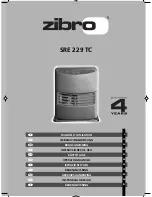
Reznor, RHC21 8000 Installation EN May 2021 D301319 Issue 0 Page No 13 of 52
4 Installation
4.1 General requirements
It is important that all gas
appliances are installed in
accordance with the rules in force
and by appropriately qualified
persons. Failure to install appliances
correctly could lead to prosecution.
It is in your own interest and that
of safety to ensure compliance with
the law.
Air heaters should not be installed
in corrosive atmospheres i.e. near
plating, spray or de-greasing plants
or in areas where there is a fire risk.
Care should be exercised when designing
ducting systems especially with regard to the
application of restriction and direction turning
fittings, i.e. elbows directly on to the air heater,
doing so can cause an uneven and turbulent air
flow across the heat exchanger resulting in heat
exchanger hot spots and nuisance shut down
of the gas burner due to localized overheating,
thus activating thermal over-heat controls.
The location must also provide sufficient space
to allow the heater to be serviced. Ensure that
the air heater is installed in a level plain and that
the surface onto which it is installed is vibration
free.
4.2 Unpacking and preparation
Prior to dispatch, the air heater was operated
and tested at the factory.
Check the shipping label and data plate to
ensure the specification of gas and electrical
supplies are compatible.
Read this document and become familiar with
the installation requirements and the appliance
before commencing installation.
4.3 Heater location
Do not locate the air heater where it may be
exposed to water spray, rain, etc. The location
chosen for the air heater must permit the
provision of a satisfactory flue system venting to
outdoor atmosphere and adequately ventilated
to provide for combustion air.
Position
mm
Top
150
Flue connector
150
Access panel
600
Non access side
150
Bottom
50
Table 7 : Installation clearances
4.4 Minimum airflow requirement
The minimum airflow duty through the heating
section (see figure 4 below) must be observed as
indicated in table 8 below.
Model
m
3
/hr
m
3
/s
RHC21 8045-09
6600
1.833
RHC21 8060-12
8750
2.431
RHC21 8075-09
10790
2.997
RHC21 8100-12
14300
3.972
RHC21 8125M15
18000
5.000
RHC21 8150M18
21000
5.833
RHC21 8175M21
21500
5.972
RHC21 8200M24
24000
6.667
Table 8 : Minimum airflow requirements
4.5 Maximum airflow condition
Special attention must be made to ensure that
the temperature rise of the air passing through
the module around the heat exchanger tubes
is high enough to avoid condensation forming
within the tubes.
This condensation forming could occur by
super cooling of the products of combustion.
Such condensation can be the source of severe
corrosion and damage to tubes or part of the
tubes.














































